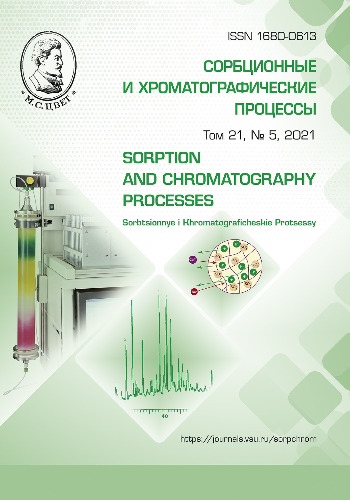A test kit with an adsorption chip for the express diagnostics of genital tract disorders
Abstract
Express diagnostics methods based on pH measurements conducted prior to empirical treatment have been gaining popularity lately. The article considers the possibility of creating a test kit with an adsorption chip based on cotton cellulose modified with an indicator for the express diagnostics of genitourinary disorders. The method is based on the biological phenomenon of changes in acidity during the development of a pathological process.
In our study, we selected an indicator that can register changes in acidity within the range of рН 5.5-7.5 and determined the optimal solvent for the preparation of a hypoallergic indicator solution with high adhesion capacity and moderate viscosity. We also determined the amount of the solution required for effective diagnostics and selected a carrier for the indicator. Bromothymol blue (3',3'-dibromothymolsulfophthalein) was chosen as an indicator.
As results of the study, the conditions for the fixation of bromothymol blue on cellulose were proposed, the conditions for the preparation of the samples were determined and the standardisation of the introduction of the sample into the chip was performed. Evaluation of the in vivo longevity of the properties of the obtained test kit was investigated. As a result of the study, we suggested a scheme for the fixation of bromothymol blue on Kotex pads. The suggested test kit, in which an adsorbed cellulose-based chip modified with an indicator serves as a sensor, is original. This sensoric can be considered a type of partition chromatography.
The effectiveness of the suggested kit was clinically tested on 50 women between the ages of 19 and 75. The control test included standard measuring of the pH of vaginal discharge followed by a microbiological study of the gram-stained smears of vaginal discharge. The study demonstrated that the processing of the obtained reaction to the change in the colour of the indicator absorbed on the carrier can be used to determine the degree of inflammation of the reproductive tract in the examined patients. The intensity of the colour of the test kit correlated with the intensity of inflammation rather than with the type of microorganisms causing the pathological process.
The analysis of the obtained data provides reliable results that can be used for the early diagnostics of genitourinary tract infections. The article also provides recommendations for the application of the test kit.
Downloads
References
Kira E.F., Dushkina E.A., Badikova N.S., Akusherstvo i ginekologiya, 2013, Vol. 3, pp. 102-106.
Myuller E`. R., Vulf A. Dzh., Brubejker L., Sovremennoe mnenie v urologii, 2017, Vol. 27, pp. 282-286.
Kira E.F., Semenova K.E., Markaryan A.M., Ginekologiya, 2014, Vol. 16, pp. 9-13.
Gillies R.J. Raghunand N., Garcia-Martin M.L., Gatenby R.A., Engineering in Medicine and Biology Magazine, 2004, Vol. 23, pp. 57-64.
Bonchev P.R. Vvvedenie v analitich-eskuyu khimiyu, Leningrad, Khimiya, 1978, 496 p.
Trukhmanov A.S., Storonova O.A., Ivashkin V.T., Rossijskij zhurnal gastroe`nterologii, gepatologii, koloproktologii, 2016, Vol. 26, pp. 55-68.
Selemenev V.F., Rudakova L.V., Ruda-kov O.B., Belanova N.A. et al., Fosfolipidy` na fone prirodny`kh matricz, Voronezh, Nauchnaya kniga, 2020, 318 p.
Khoroshikh N.V., Mady`kin Yu.Yu., Mittova V.O., Solov`eva A.A., Prikladny`e informaczionny`e aspekty` medicziny`, 2019, Vol. 22, pp. 85-89.
Khoroshikh N.V., Mady`kin Yu.Yu., Mittova V.O., Solov`eva A.A., Prikladny`e informaczionny`e aspekty` medicziny`, 2019, Vol. 22, pp. 90-94.
Mady`kin Yu.Yu., Khoroshikh N.V., Mittova V.O., Zolotukhin O.V., Patent RF. 2743428, 2021.
Kazniczina P.A., Kupletckaya N.B., Primenenie UF-IK i YaMR spektrosko-pii v organicheskoj khimii, M., Vy`sshaya shkola, 1971, 264 p.
Dekhant I., Dancz R., Kimmer V., Shmol`ke R., Infrakrasnaya spektroskopiya polimerov, M., Khimiya, 1976, 471 p.
Sabnis R.W., Handbook of Acid-Base Indicators, New York, CRC Press, 2007, 416 p.
Savicheva A.M., Tapil`skaya N.I., Ship-iczy`na E.V., Vorob`eva N.E., Akusherstvo i ginekologiya, 2017, Vol. 5, pp. 24-31
Bagnall P., Rizzolo D., Journal of the American Academy of Physician Assistants, 2017, Vol. 30, pp. 15-21.
Sherrard J., Wilson J., Donders G, Mendling W. et al., International Journal of STD&AIDS, 2018, Vol. 29, pp. 1258-1272
Malova I.O., Afanas`eva I.G., Gusevskaya K.A., Akusherstvo i ginekologiya: Novosti, mneniya, obuchenie, 2019, Vol. 7, pp. 79-86
Sgibnev A., Kremleva E.I., Probiotics and antimicrobial proteins, 2017, Vol. 9, pp. 131-141
Diagnostika infekczij v akushersko-ginekologicheskoj i neonatologicheskoj praktike, uchebnoe posobie, M., Raduga, 2018, 124 p.







